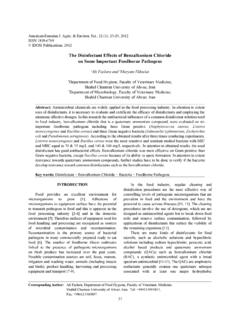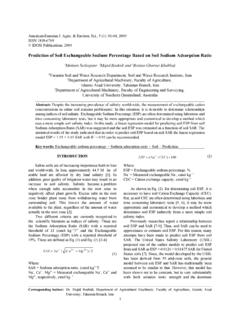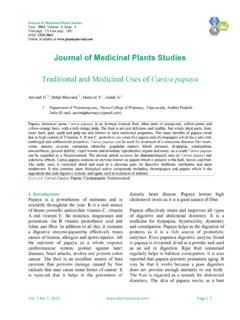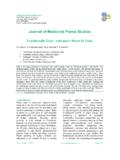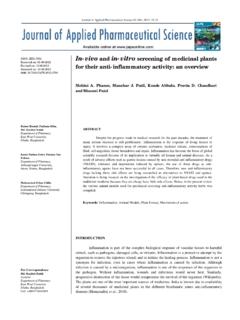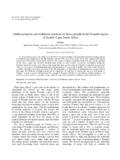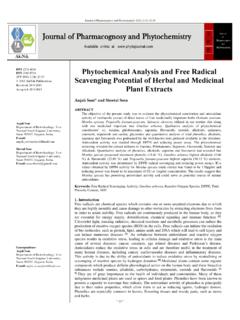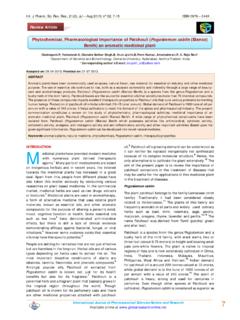Transcription of Antimicrobial Activity of Some Important …
1 World Journal of Agricultural Sciences 4 (S): 839-843, 2008. ISSN 1817-3047. IDOSI Publications, 2008. Antimicrobial Activity of some Important Medicinal Plant Against Plant and Human Pathogens 1. B. Mahesh and 2S. Satish Department of Studies in Applied Botany and Biotechnology, 1. University of Mysore, Manasagangotri, Mysore-570 006. 2. Herbal Drug Technology Laboratory, Department of Studies in Microbiology, University of Mysore, Manasagangotri, Mysore-570 006. Abstract: The methanol leaf extracts of Acacia nilotica, Sida cordifolia, Tinospora cordifolia, Withania somnifer and Ziziphus mauritiana showed significant antibacterial Activity against Bacillus subtilis, Escherichia coli, Pseudomonas fluorescens, Staphylococcus aureus and Xanthomonas axonopodis pv.
2 Malvacearum and antifungal Activity against Aspergillus flavus, Dreschlera turcica and Fusarium verticillioides when compare to root/ bark extracts. A. nilotica and S. cordifolia leaf extract showed highest antibacterial Activity against B. subtilis. and Z. mauritiana leaf extract showed significant Activity against X. a. pv. malvacearum. Root and leaf extract of S. cordifolia recorded significant Activity against all the test bacteria. A. nilotica bark and leaf extract showed significant antifungal Activity against A. flavus, Ziziphus mauritiana and Tinospora cordifolia recorded significant antifungal Activity against D. turcica The methanol extract of Sida cordifolia exhibited significant antifungal Activity against F.
3 Verticillioides. Key words: Antibacterial Antifungal Medicinal plants INTRODUCTION drugs from higher plants continue to occupy an Important niche in modern medicine. On a global basis, atleast The use of medicinal plants as a source for relief from 130 drugs, all single chemical entities extracted from illness can be traced back over five millennia to written higher plants, or modified further synthetically, are documents of the early civilization in China, India and the currently in use, though some of them are now being Near east, but it is doubtless an art as old as made synthetically for economic reasons [5]. mankind. Neanderthals living 60,000 years ago in present Medicinal plants represent a rich source of day Iraq used plants such as hollyback, these plants are Antimicrobial agents.
4 Plants are used medicinally in still widely used in ethnomedicine around the world different countries and are a source of many potent and [1,2]. powerful drugs [6]. A wide range of medicinal plant parts The potential of higher plants as source for new is used for extract as raw drugs and they possess varied drugs is still largely unexplored. Among the estimated medicinal properties. The different parts used include 250,000-500,000 plant species, only a small percentage has root, stem, flower, fruit, twigs exudates and modified plant been investigated phytochemically and the fraction organs. While some of these raw drugs are collected in submitted to biological or pharmacological screening is smaller quantities by the local communities and folk even smaller.
5 Thus, any phytochemical investigation of a healers for local used, many other raw drugs are collected given plant will reveal only a very narrow spectrum of its in larger quantities and traded in the market as the raw constituents. Historically pharmacological screening of material for many herbal industries [7]. Although compounds of natural or synthetic origin has been the hundreds of plant species have been tested for source of innumerable therapeutic agents. Random Antimicrobial properties, the vast majority of have not screening as tool in discovering new biologically active been adequately evaluated [8]. Considering the vast molecules has been most productive in the area of potentiality of plants as sources for Antimicrobial drugs antibiotics [3,4].
6 Even now, contrary to common belief, with reference to antibacterial and antifungal agents, a Corresponding Author: S. Satish, Herbal Drug Technology Laboratory, Department of Studies in Microbiology, University of Mysore, Manasagangotri, Mysore- 570 006. 839. World J. Agric. Sci., 4 (S): 839-843, 2008. systematic investigation was undertaken to screen the the thimble and extracted successively with methanol local flora for antibacterial and antifungal Activity from solvent in Soxhlet extractor for 48h. The solvent extracts Acacia nilotica, Sida cordifolia, Tinospora cordifolia, were concentrated under reduced pressure and preserved Ziziphus mauritiana and Withania somnifera.
7 The at 5 C in airtight bottle until further use. Acacia nilotica (L.) Willd. belongs to the family Mimosaceae. Decoction of bark is used as gargle and of Growth and Maintenance of Test Microorganism for pods in urino-genital diseases. Sida cordifolia L. Antimicrobial Studies: Bacterial cultures of (Malvaceae) root is used in pain, nervous disorders, Bacillus subtilis (B. subtilis), Escherichia coli (E. coli), coryza, cardiac diseases. The stem of Tinospora Pseudomonas fluorescens (P. fluorescens), cordifolia (Wild.) & Th. which belongs to the family Staphylococcus aureus (S. aureus) and Xanthomonas Menispermaceae is used as an ingredient for Ayurvedic axonopodis pv.
8 Malvacearum (X. axonopodis pv. preparations used in general debility, dyspepsia, fevers malvacearum) and fungal cultures of Aspergillus flavus and urinary diseases. Root is a powerful emetic and used (A. flavus), Dreschlera turcica (D. turcica) and for visceral obstruction; its watery extracts is used in Fusarium verticillioides (F. verticillioides), were leprosy. Withania somnifera (L.) Dunal which belong to obtained from the culture collection centre, Department of the family Solanaceae is used in hiccup, cough, dropsy, Applied Botany and Biotechnology, University of rheumatism and gynaecological disorders an as a sedative Mysore, India, were used for Antimicrobial test organisms.
9 In senile debility. It is also useful in inflammatory The bacteria were maintained on nutrient broth (NB) at conditions, ulcers and scabies as external application. 37 C and fungus were maintained on Potato dextrose agar Leaves used as a febrifuge and applied to lesions painful (PDA) at 28 C. swellings and sore eyes. Ziziphus mauritiana Lam. Belongs to the family Rhamnaceae. The fruits used Preparation of Inoculum: The gram positive anodyne and tonic. They form one of the ingredients of (Bacillus subtilis and Staphylococcus aureus) and gram Joshanda, a medicine used in chest troubles. Kernels negative bacteria (Escherichia coli, Pseudomonas sedative, used as soporific and to stop vomiting; also fluorescens and Xanthomonas axonopodis pv.)
10 Employed as an antidote to aconite-poisoning and in malvacearum) were pre-cultured in nutrient broth abdominal pains. Seeds are given in diarrhea. Leaves with overnight in a rotary shaker at 37 C, centrifuged at 10,000. catechu (Areca catechu) used as an astringent and rpm for 5 min, pellet was suspended in double distilled considered diaphoretic. [9]. water and the cell density was standardized spectrophotometrically (A610 nm). The fungal inoculum MATERIALS AND METHODS (F. verticillioides, D. turcica and A. flavus) was prepared from 5 to 10 day old culture grown on Potato Collection of Plant Material: Fresh leaves bark and root dextrose agar medium. The Petri dishes were flooded with of five different plants viz.

